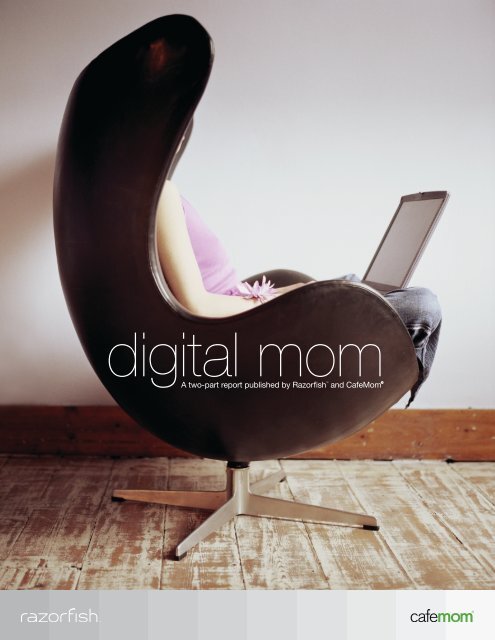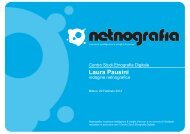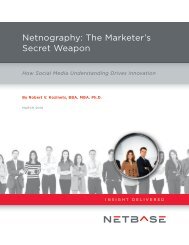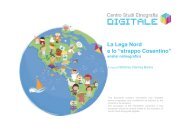A two-part report published by Razorfish and CafeMom
A two-part report published by Razorfish and CafeMom
A two-part report published by Razorfish and CafeMom
You also want an ePaper? Increase the reach of your titles
YUMPU automatically turns print PDFs into web optimized ePapers that Google loves.
TMC<strong>Razorfish</strong> LLC. All rights reserved.
RRcontentspageIntroductionPart 01Connecting with Digital Mom through Emerging TechnologiesTM<strong>by</strong> Terri Walter, VP Emerging Media, <strong>Razorfish</strong>,TMwith analysis <strong>by</strong> Ella Chinitz, Senior Consultant, Consumer Insights Group, <strong>Razorfish</strong>Key Findings01. Digital moms are active users of Web 2.0 technologies.02. Age does matter, both the mom’s age <strong>and</strong> the child’s.03. Moms’ motivations for using emerging channels change as their children grow.04. “Whom moms communicate with” is changing.05. Moms may be moms, but they are also women with interests beyond parenting.06. Digital moms first learn about products via many channels.040507080911121314Part 02Connecting with Digital Mom through Social Ne<strong>two</strong>rks<strong>by</strong> Laura Fortner, SVP Marketing <strong>and</strong> Insights, <strong>CafeMom</strong>with analysis <strong>by</strong> Steven Armour, Director of Research, <strong>CafeMom</strong>Key FindingsThe Self ExpressorThe Utility MomThe GroupsterThe InfoseekerThe Hyperconnector1719212325272931ConclusionsTMRA joint <strong>report</strong> <strong>by</strong> <strong>Razorfish</strong> <strong>and</strong> <strong>CafeMom</strong> 02
03 Digital Mom 2009
introbeing a mom today is challengingNot only is a mom h<strong>and</strong>ling the responsibilities of caring forher children <strong>and</strong> managing the household, but she is jugglingwork dem<strong>and</strong>s, keeping close tabs on her family <strong>and</strong> their needs,<strong>and</strong> maintaining friendships. She is also looking for outlets for“me time” <strong>and</strong> leisure time with her family despite complexschedules. On the shopping front, mom finds herself confrontedwith more br<strong>and</strong>s <strong>and</strong> products than ever before, yet she hasan overabundance of information with little time to researchthe best options for herself <strong>and</strong> family. It’s no wonder that 70%of Americans say moms today have it tougher than theircounter<strong>part</strong>s did 20 or 30 years ago.So how does mom manage? Today’s mom has become quiteresourceful in adopting technology <strong>and</strong> social media to helpher “do it all”—we call her “digital mom.”She is way beyond programming the VCR, checking answeringmachine messages, <strong>and</strong> emailing. Now, she’s likely to bemanaging the household DVR library or downloading videos/podcasts to teach <strong>and</strong> entertain; relaxing with casual ormultiplayer games; using her mobile phone to text her familyor browse the Web; <strong>and</strong> meeting <strong>and</strong> connecting with a widerrange of “friends” than ever before through online socialne<strong>two</strong>rks. And digital moms are not a niche; they have, in fact,become the mainstream, representing an estimated 84% ofmoms online in the U.S. today.Women with children highly value social media, mobile <strong>and</strong> otherdigital technologies as a convenient means to stay connected,seek advice <strong>and</strong> information, shop <strong>and</strong> learn about products,meet others like themselves, <strong>and</strong> simplify the many dimensionsof their lives. Digital technologies <strong>and</strong> social media are alsoproviding new emotional <strong>and</strong> social outlets for moms includingnew ways to express themselves, get support from others, orjust have fun. And as their habits change, how we market tomoms also needs to change.Digital Mom, a <strong>two</strong>-<strong>part</strong> study conducted <strong>by</strong> <strong>Razorfish</strong> <strong>and</strong><strong>CafeMom</strong>, looks at the ways technology <strong>and</strong> social media areaffecting moms’ lives today—everything from how they parent,socialize <strong>and</strong> keep in touch, to how they shop. It also considerswhat marketers need to do to reach this evolving <strong>and</strong> highlyinfluential segment.312Through “Part One—Connecting with Digital Mom throughEmerging Technologies:”• Learn about the ways moms are consuming media <strong>and</strong> therange of emerging technologies they have embraced—theyare more tech-savvy than you think.• Gain perspective on how the ages of both mothers <strong>and</strong> theirchildren affect digital behaviors <strong>and</strong> category interests.• Hear which channels wield the most influence on moms’purchasing decisions <strong>and</strong> shopping behaviors <strong>by</strong> vertical <strong>and</strong>how marketers can connect best.Through “Part Two—Connecting with Digital Mom throughSocial Ne<strong>two</strong>rks:”• Underst<strong>and</strong> how <strong>and</strong> why moms use social media—theiractivities <strong>and</strong> motivations may surprise you.• Determine what information channels moms trust most, <strong>and</strong>which are most influencing their shopping behavior <strong>and</strong>purchasing decisions.• Meet our five core segments of socially connected momsthat represent a diverse mix of varied life experiences, values<strong>and</strong> motivations:• The Self Expressor• The Utility Mom• The Groupster• The Infoseeker• The Hyperconnector• Learn how these insights apply to marketers <strong>and</strong> whatapproaches br<strong>and</strong>s should adopt to reach <strong>and</strong> connect witheach of these key mom groups.It is clear that how moms communicate <strong>and</strong> whom they trustis fundamentally changing. Underst<strong>and</strong>ing how to leverageemerging technologies, <strong>and</strong> the growing social influence of thedigital mom, is a critical step for marketers in a changing medial<strong>and</strong>scape.1. The Pew Research Center. Motherhood Today: Tougher Challenges, Less Success. May 2, 2007.2. Digital Moms, as defined <strong>by</strong> the <strong>Razorfish</strong> survey, are Internet moms aged 18-64 who have <strong>report</strong>edusing at least <strong>two</strong> Web 2.0 technologies in the last three months, <strong>and</strong> have researched, sought adviceor purchased online in one of twelve categories in the last three months. See Methodology, page06 for more details.3. Findings project to 84% of online women with children under 18 in the household, as per NielsenNetRatings @Plan Winter 2008/2009.TMRA joint <strong>report</strong> <strong>by</strong> <strong>Razorfish</strong> <strong>and</strong> <strong>CafeMom</strong> 04
<strong>part</strong> 01Connecting with Digital Mom through Emerging Technologies<strong>by</strong> Terri Walter, VP Emerging Media, <strong>Razorfish</strong>, TMwith analysis <strong>by</strong> Ella Chinitz, Senior Consultant, Consumer Insights Group, <strong>Razorfish</strong> TMmoms are the ultimate multitaskers4According to Nielsen NetRatings, there are 32 million women in the U.S. who have children under 18 <strong>and</strong> go online,which translates to about 40% of all women online in the U.S. today. This changing segment carries so much weightin the household: moms are typically the key influencers <strong>and</strong> purchasers for both themselves <strong>and</strong> their families. Buthave moms changed with the media l<strong>and</strong>scape? What is the role of digital technology in their lives?To answer these questions, <strong>Razorfish</strong> surveyed 1,500 online moms who are <strong>report</strong>ed users of at least <strong>two</strong> Web 2.0technologies <strong>and</strong> have actively researched or purchased online in the last three months, a group we call “digital moms.”Through our research, we set out to answer the following questions: Who is the digital mom, <strong>and</strong> how is she usingdigital technology? Do her habits differ <strong>by</strong> age? How does she manage her interests vs. her child’s interests? Whatare her motivations for engaging in social media <strong>and</strong> other emerging channels? What channels does she respondto best, <strong>and</strong> does this differ <strong>by</strong> interest/vertical market? How should marketers engage her?What we found was that moms are the ultimate multitaskers; they are leveraging digital <strong>and</strong> emerging technologiesmore than ever before, but in ways you may not expect.Digital Moms are Mainstream <strong>and</strong> MultidimensionalHow moms prioritize <strong>and</strong> balance the roles of self, mom, wife, employee, <strong>and</strong> friend may differ, but one thing is certain:digital technologies are making things easier. According to our survey, more digital moms today interact with socialne<strong>two</strong>rks (65%) <strong>and</strong> SMS (56%) than with news sites (51%), <strong>and</strong> just as many can be found gaming online or viaa gaming console (52%). These findings demonstrate just how mainstream these new channels have become.Digital moms are multidimensional in their online behaviors, <strong>and</strong> their interests extend beyond parenting. Digitalmoms are more likely to connect with friends than with family using digital technologies, <strong>and</strong> they are not afraid toseek advice or companionship from known or anonymous friends. Additionally, interests like Clothing/Fashion <strong>and</strong>Cooking/Food remain the most popular, <strong>and</strong> consistently so, regardless of a woman’s age; while other categoryinterests like Ba<strong>by</strong>/Parenting, Telecommunications, Medication/Medical Condition are lifestage-oriented <strong>and</strong> changeas their children grow.The Digital Divide: Age Matters, Both the Mom’s Age <strong>and</strong> the Child’sBut which technologies digital moms use most depends on factors including the age of the mom, the age of the child,<strong>and</strong> motivation. Moms under 35 are significantly more likely to leverage newer communications platforms likesocial ne<strong>two</strong>rks, SMS, <strong>and</strong> mobile browsing; while moms 45 <strong>and</strong> older are more likely to utilize informational toolslike online news, consumer reviews, <strong>and</strong> podcasting. Interestingly, online video consumption (41% vs. 36%) <strong>and</strong>gaming (57% vs. 51%) are highest among moms with children 12 <strong>and</strong> older (vs. moms with children under 12), <strong>and</strong>this group is also more likely to be online monitoring their children. <strong>Razorfish</strong> believes that motivations such asinteracting or monitoring their children online, as well as the likely differences in leisure time activities among momsof children 12 <strong>and</strong> older, might play a factor in the adoption of these technologies.05 Digital Mom 20094. Findings project to 84% of online women with children under 18 in the household, as per Nielsen NetRatings @Plan Winter 2008/2009.
RDigital Channels are Strong at all Stages of the Purchase FunnelCompared to other media sources like magazines, newspaper <strong>and</strong> radio, digital channels continue to wield influence inall phases of the purchase decision cycle among digital moms. In our questions to digital moms who have researchedor purchased a product in one of twelve major product categories in the last three months, the following trendswere discovered:• The gap is closing between TV <strong>and</strong> digital channels in creating initial awareness of a product.• Websites, search engines, <strong>and</strong> friends/family, along with social influence channels <strong>and</strong> magazines, are more widelyused <strong>and</strong> trusted for researching/learning than any other sources.• Social activities continue to play an important role in influencing digital moms. Since many social environmentscontain more than one social activity, it is important to consider the combined effect of social influence channels—online consumer reviews, RSS, social ne<strong>two</strong>rks <strong>and</strong> blogs.• Emerging channels like mobile <strong>and</strong> podcasting are also having influence at different stages in the purchase funnel,although this varies <strong>by</strong> vertical, <strong>and</strong> penetration is still relatively low.These trends indicate the growing power digital channels have in influencing a mom’s numerous purchasingdecisions, both for herself <strong>and</strong> her family. It is evident that as consumption patterns shift, channels like social media,mobile <strong>and</strong> gaming must be better understood for marketers to effectively reach digital moms, both in their rolesas individuals <strong>and</strong> as caregivers.MethodologyThe <strong>Razorfish</strong> survey looked at <strong>two</strong> major trends: 1) the current penetration <strong>and</strong> usage of digital/emergingtechnologies; <strong>and</strong> 2) the impact of different channels in the media mix across twelve verticals.To meet these goals, we collected 1,500 survey responses among a demographically representative sampleof women, aged 18-64 with at least one child under 18 yrs. old in the household. The survey was conducted<strong>by</strong> Insight Express via panel email recruitment in October, 2008.The learnings are representative of panel recruited <strong>part</strong>icipants we are calling “digital moms:”• Moms must have <strong>report</strong>ed active engagement with <strong>two</strong> or more Web 2.0 technology channels in the lastthree months. Channels included: social media, text messaging (SMS), mobile browsing, online video, realsimple syndication (RSS), instant messaging, gaming, online consumer reviews, blogs, digital video recorders(DVRs/TiVo ) <strong>and</strong> audio/video podcasting.• Moms must have also researched, sought advice or purchased online in at least one of twelve vertical marketsin the last three months. Verticals included: Ba<strong>by</strong>/Parenting, Banking Services, Brokerage Services, Cars,Clothing/Fashion, Electronics/Computers, Food/Cooking, Health/Fitness, Homegoods/Appliances/Furniture,Medication/Medical Condition, Telecommunications <strong>and</strong> Travel.Findings project out to 84% of the population of moms online in the U.S., or about 27 million women,(Nielsen NetRatings @Plan Winter 2008/2009), <strong>and</strong> all data analysis is statistically significant at the 90%confidence level.TMRA joint <strong>report</strong> <strong>by</strong> <strong>Razorfish</strong> <strong>and</strong> <strong>CafeMom</strong> 06
key findings07 Digital Mom 2009
RR01. Beyond email <strong>and</strong> search, digital moms are active users of Web 2.0 technologies.More digital moms are interacting with social ne<strong>two</strong>rks, text messaging, <strong>and</strong> instantmessaging than with news sites, <strong>and</strong> just as many are gaming online or via a gaming console.Digital channel usage can be divided into three tiers:MAJORITY: channels used <strong>by</strong> more than 50% of digital moms include: social ne<strong>two</strong>rks (65%), text messaging (56%),instant messaging (55%) <strong>and</strong> gaming (52%). These channels join email (94%), search engines (74%) <strong>and</strong> newssites (51%) as staples in the media diet of digital moms.MAINSTREAM: channels used <strong>by</strong> roughly one-third of digital moms include: online video (36%), online consumerreviews (33%), blogs (29%) <strong>and</strong> DVR/TiVo (29%).NICHE/DEVELOPING: channels used <strong>by</strong> less than 25% of digital moms include: RSS (21%), audio/video podcasting(10%) <strong>and</strong> mobile browsing (10%).Digital channel usage (which technologies have you used in the last 3 months)100%95%90%Majority Mainstream Niche/Developing80%74%70%65%60%50%56% 55%52% 51%40%30%36%33%29% 29%20%21%10%11% 10%0%EmailSearch EnginesSocial Ne<strong>two</strong>rk SitesText Messaging (SMS)Instant MessagingGaming (online or console)News SitesOnline VideoOnline Consumer ReviewsBlogsDVR / TiVoRSS FeedsAudio or Video PodcastMobile Web BrowsingImplications for Marketers:Social media <strong>and</strong> text messaging, instant messaging, <strong>and</strong> gaming, now used <strong>by</strong> the majority of digital moms, are no longerniche activities. It will be necessary for marketers to embrace channels that engage more than 50% of all digital moms,<strong>part</strong>icularly as mass marketing channels shrink. Marketers should also be investing in marketing in channels like online video,blogs, <strong>and</strong> DVR as they go mainstream with the digital mom audience since learnings today will be critical for the future.In terms of channels like RSS, podcasting <strong>and</strong> mobile browsing where penetration is under 25%, our research indicates<strong>two</strong> trends: 1) users who fully embrace these channels are highly passionate about them; <strong>and</strong> 2) channels like podcasting<strong>and</strong> mobile are utilized more heavily within specific verticals (i.e. Medical,Telecommunications).While podcasting <strong>and</strong> RSS have been around for years, we are only now seeing the buds of growth in mobile browsingamong all U.S.-based consumers. We predict much more activity <strong>and</strong> adoption of mobile browsing among digital momsas a subset of the broader population in coming years, <strong>part</strong>icularly as smartphone penetration increases.Marketers would do well to underst<strong>and</strong> how these three levels of channel usage are changing the media consumption patternsof moms overall <strong>and</strong> how these channels can work together in the marketing mix for maximum reach <strong>and</strong> effectiveness.TMRA joint <strong>report</strong> <strong>by</strong> <strong>Razorfish</strong> <strong>and</strong> <strong>CafeMom</strong> 08
02. Age does matter, both the mom’s age <strong>and</strong> the child’s. 5a. Key differences exist in digital usage between older <strong>and</strong> younger moms.Digital moms under 35 are more likely to leverage newer communications platforms like social ne<strong>two</strong>rks (72%), SMS(64%) <strong>and</strong> mobile browsing (13%); while moms 45 <strong>and</strong> older are more likely to utilize deeper informational tools likenews sites (61%), online consumer reviews (43%), <strong>and</strong> podcasting (12%). In terms of entertainment, moms 35-44 aremost likely to use a DVR (37%), while moms 45+ are significantly more likely to game than moms 35-44 (55% vs. 48%).b. Key differences also exist among moms based on the age of their children.Digital moms of children 12 <strong>and</strong> older, versus moms with children under 12, are more likely to watch online video(40% vs. 34%), game (57% vs. 51%), read online consumer reviews (38% vs. 30%), <strong>and</strong> watch or listen to podcasts(13% vs. 9%); while moms of children younger than 12 are more likely to use social ne<strong>two</strong>rks (67% vs. 62%).As it is likely that a majority of moms with children 12 <strong>and</strong> older are also older themselves, it is not surprising thatmany of these trends mirror the divide we see between women under 35 <strong>and</strong> women over 45. But the exceptionsare online video <strong>and</strong> gaming, which are significantly higher for digital moms with children 12 <strong>and</strong> over, indicatingthat parenting stage, interaction with their children online, <strong>and</strong>/or leisure time differences might play a factor in theadoption of these technologies.Implications for Marketers:Based on their consumption habits, digital moms who are younger in age tend to be more comfortable withnewer communications tools like social ne<strong>two</strong>rks <strong>and</strong> SMS, whereas older moms tend to be more comfortablewith information channels online. At the same time, moms with children 12 or older are more likely than momsof children under 12 to use gaming <strong>and</strong> video. Marketers have an opportunity to respond to these trends <strong>by</strong>acknowledging that a “one-size-fits-all” strategy against moms may not work. It will be important to segment<strong>by</strong> age <strong>and</strong> continue to follow these trends year over year to ensure that marketing programs are speaking toeach set of moms in their technology comfort zone.09 Digital Mom 20095. All findings are significant at the 90% confidence level.
RRa. Age of Mom: Digital Channel UsageEmailSocial Ne<strong>two</strong>rk SitesSearch EnginesText Messaging (SMS)Gaming (Online or Console)Instant MessagingNews SitesOnline VideoDVR / TiVoBlogsOnline Consumer ReviewsRSS FeedsMobile Web BrowsingAudio or Video Podcast5%8%13%10%11%12%22%25%20%22%22%28%34%28%29%30%35%37%41%38%39%43%43%49%53%48%53%54%55%57%58%56%61%64%66%72%72%75%76%95%95%96%0% 25% 50%75% 100%18-34 35-4445+b. Age of Child: Digital Channel UsageEmail95%95%Search Engines74%77%Social Ne<strong>two</strong>rk Sites62%67%Text Messaging (SMS)59%56%Instant Messaging53%57%Gaming (Online or Console)51%57%News Sites48%58%Online Video34%40%DVR / TiVo31%31%Online Consumer Reviews30%38%Blogs29%31%RSS Feeds22%23%Mobile Web Browsing11%10%Audio or Video Podcast9%13%0% 25% 50%75% 100%0-11 12-18TMRA joint <strong>report</strong> <strong>by</strong> <strong>Razorfish</strong> <strong>and</strong> <strong>CafeMom</strong> 10
03. Moms’ motivations for using emerging channels change as their children grow.Digital moms with older children have a dual reason to stay connected via emerging technologies. Beyond the needto stay connected to friends <strong>and</strong> family, more moms with children 12 or older are interacting with technology to monitortheir children. Of moms who use social ne<strong>two</strong>rks <strong>and</strong> have children ages 12-18, about half (47%) are monitoringtheir child’s behavior. This is similar for moms who access blogs <strong>and</strong> have children ages 12-15—about 40% aremonitoring their child’s blog activities.This trend shows just how important it is to moms to learn <strong>and</strong> grow with their children as they embrace more openforms of communication, like social media <strong>and</strong> blogs.Implications for Marketers:Marketers should recognize the dual purposes moms of older children have for engaging with emergingtechnologies, <strong>part</strong>icularly social channels. They should learn more about the challenges moms face whenembracing technology, <strong>and</strong> provide them with better resources <strong>and</strong> information to help them guide theirchildren. Marketers have an opportunity to empower moms with content, experiences, <strong>and</strong> a community totap into their dual motivations - staying connected for their own needs, as well as the needs of their children.11 Digital Mom 2009
04. “Whom moms communicate with” is changing.Digital technologies play an important role in how digital moms socialize <strong>and</strong> connect. Digital moms use channels suchas social ne<strong>two</strong>rks, SMS <strong>and</strong> email to connect with their friends at higher rates than with their spouse, children, colleagues,or other family. According to our survey of digitally active moms, 65% are now communicating with their known (<strong>and</strong>unknown) friends via social media, while 56% are text messaging, <strong>and</strong> 52% are gaming (often with anonymous friends).• Of those who use social ne<strong>two</strong>rks, 83% of digital moms connect with friends <strong>and</strong> 35% connect with strangers oronline friends vs. only 24% <strong>and</strong> 20% connecting with spouse/<strong>part</strong>ner <strong>and</strong> children, respectively.• Digital mom gamers, on the other h<strong>and</strong>, are most likely to play with strangers or online friends (47%), but they arealso enjoying games with their spouse/<strong>part</strong>ner (36%), children (30%) <strong>and</strong> friends (28%).• Texting is just as popular with friends (74%) as it is with spouse/<strong>part</strong>ner (72%), <strong>and</strong> more moms use texting or SMSto communicate with their children (40%) than any other channel (gaming is next at 32%).Beyond the family, the school, the town, or the workplace, moms are more likely than ever before to have a communityof known <strong>and</strong> unknown friends online that is cinched <strong>by</strong> common interests rather than demographics.Whom Moms Communicate with <strong>by</strong> Channel100%90%80%70%72%84%83%79%74%60%50%52%47%40%30%20%32%24%36%40%31%32%27%20%28%26%24%35%10%0%Spouse/Partner Child(ren) Friends Strangers orOnline FriendsEmail Text Messaging Instant Messaging Social Ne<strong>two</strong>rking Gaming7%Implications for Marketers:Marketers should consider how to connect with moms <strong>and</strong> their social circles, in <strong>and</strong> around common interests,<strong>and</strong> underst<strong>and</strong> how their products <strong>and</strong> services intersect with the needs of moms in their various mindsets.As more moms use these channels to connect with others outside the immediate family circle, it is importantto realize that their receptivity to certain types of messaging (i.e. family-related messaging) might change.Marketers have an opportunity to utilize communications channels like social ne<strong>two</strong>rking, text messaging<strong>and</strong> gaming to facilitate conversation among moms <strong>and</strong> influence decision making. However, garnering a betterunderst<strong>and</strong>ing of how moms use these channels <strong>and</strong> who they are socializing with will be critical to success.TMRA joint <strong>report</strong> <strong>by</strong> <strong>Razorfish</strong> <strong>and</strong> <strong>CafeMom</strong> 12
05. Moms may be moms, but they are also women with interests beyond parenting.When asked to select the top items researched or purchased online in the last three months, most digital momsselected Fashion/Clothing (40%). This was followed <strong>by</strong> Food/Cooking (31%), Ba<strong>by</strong>/Parenting (26%), Banking(22%), Electronics/Computers (21%), Travel (21%) <strong>and</strong> Medication/Medical Condition (20%). However, women withchildren under the age of 5 were significantly more likely to select Ba<strong>by</strong>/Parenting (46%).Across some verticals, moms’ interests change as children grow, while other interests transcend time. Moms’ interestsin lifestyle content (Health/Fitness, Fashion/Clothing, Travel, Food/Cooking) remains consistent regardless of howold their children are, while their consumption of life-stage content (Ba<strong>by</strong>/Parenting, Medication/Medical Condition,Computers/Electronics, Cars <strong>and</strong> Telecommunications) evolves as their children grow.Categories in which moms researched, sought advice, or purchased (in the last 3 months)50%45%40%40%35%30%25%20%31%26%22%21% 21%20%18%15%10%14% 14%12%5%0%2%Clothing / Fashion AccessoriesFood / CookingBa<strong>by</strong> / ParentingBanking ServicesElectronics / ComputersTravelMedication / Medical ConditionHealth / FitnessHomegoods / Appliances / FurnitureTelecommunicationsCarsBrokerage ServicesImplications for Marketers:Marketers should consider marketing to mom as both an interconnected woman <strong>and</strong> a mom, as her interestsextend beyond parenting.Marketers should note that categories including Clothing/Fashion, Food/Cooking, Health/Fitness <strong>and</strong> Travelappeal to all women, regardless of a mom’s age or the age of her child. However, some interests are dependenton the age of her children. Marketers need to consider this aspect of segmentation when marketing productsin categories such as Ba<strong>by</strong>/Parenting, Medication/Medical Condition, Electronics/Computers, Cars <strong>and</strong>Telecommunications, noting that interest levels in these categories vary based on the age of the children inthe household.13 Digital Mom 2009
06. Digital moms first learn about products via many channels, including TV, friends/family <strong>and</strong> websites; however, digital <strong>and</strong> social influence channels wield more impactin the purchase funnel as mom gets closer to purchase.Although TV (31%) still has the most impact in creating awareness about a product across most verticals, the gapbetween TV <strong>and</strong> other channels is closing.First Hearing About ItIn asking digital moms which channels had a strong influence on them “first hearing about” a product, they werelargely divided, with channels as diverse as email <strong>and</strong> search, podcasting, mobile browsing <strong>and</strong> social influencegarnering between 26% <strong>and</strong> 20%, along with radio (22%) <strong>and</strong> newspaper (20%). <strong>Razorfish</strong> believes that this finding,which shows only a 10 point spread among the majority of media channels, is confirmation of the broad mediafragmentation digital moms are experiencing <strong>and</strong> the growing power of digital channels in creating initial awarenessabout products.Channel impact: First hearing about itTVReferral from friends or familyGeneral WebsitesEmailMagazinesAudio or video podcastSearch enginesMobile Web browsingRadioSocial influence channelsNewspapersText messagingOnline video26%26%24%22%22%22%20%20%17%17%29%29%31%0% 5% 10% 15% 20% 25% 30% 35% 40% 45% 50%TraditionalDigitalLearning/ResearchingOnline communication channels like search (50%), websites (50%), referrals from friends/family (31%) <strong>and</strong> othersocial influence channels are more widely used <strong>and</strong> trusted for learning/researching than any other sources. Magazinesare also highly influential (29%) in this phase of purchasing, although other traditional channels like TV (26%), newspapers(22%) <strong>and</strong> radio (18%) are not as widely cited as having influence.Beyond friends <strong>and</strong> family referrals, which might happen through social ne<strong>two</strong>rks or traditional word of mouth, socialresources like online consumer reviews, blogs, ne<strong>two</strong>rks <strong>and</strong> RSS play an important role in influencing digital moms.Not only is social ne<strong>two</strong>rk usage high on the penetration scale, but social channels like online consumer reviewsare having an important effect on how <strong>and</strong> from whom moms get their information. Since many social environmentscontain more than one social activity, it is important to consider the combined effect of social influence channels—online consumer reviews, RSS, social ne<strong>two</strong>rks, blogs—<strong>and</strong> have a comprehensive strategy to leverage them.TMRA joint <strong>report</strong> <strong>by</strong> <strong>Razorfish</strong> <strong>and</strong> <strong>CafeMom</strong> 14
Perhaps more interesting is how channel influence in these first <strong>two</strong> stages changes <strong>by</strong> category. For example, whilepodcasting is still low in terms of penetration, it ranks highly in both the initial awareness <strong>and</strong> learning stages for theBa<strong>by</strong>/Parenting <strong>and</strong> Medical categories among the podcasting user base. Additionally, mobile web browsing rankshighly (close to websites <strong>and</strong> search engines as both an awareness <strong>and</strong> learning channel) among mobile users inthe Brokerage, Telecommunications, Computer/Electronics <strong>and</strong> Car categories.Channel impact: Learning more about it or researching itSearch enginesGeneral WebsitesReferral from friends or familySocial influence channelsMagazinesMobile Web browsingEmailTVAudio or video podcastOnline videoNewspapersRadioText messaging17%18%22%22%31%29%29%28%28%26%25%50%50%0% 5% 10% 15% 20% 25% 30% 35% 40% 45% 50%Making a Decision/PurchasingWebsites, friends/family referrals <strong>and</strong> search engines are the three most cited influences among moms in the laststage of the purchase funnel. What is noteworthy is how highly mobile web browsing rates, despite its low penetration(10% usage among digital moms), underscoring the increasing potential the channel has to impact purchasing asit becomes more mainstream.Channel impact: Making a decision or purchasing itGeneral WebsitesReferral from friends or familySearch enginesMobile Web browsingTVSocial influence channelsMagazinesEmailNewspapersOnline videoAudio or video podcastText messagingRadio7%6%6%5%5%12%11%10%10%10%19%21%24%0% 5% 10% 15% 20% 25% 30% 35% 40% 45% 50%TraditionalDigital15 Digital Mom 2009
Implications for Marketers:Among digital moms, the gap is closing between TV <strong>and</strong> other channels in creating initial awareness aboutproducts. Marketers should consider the penetration level <strong>and</strong> relative influence of each channel when determininghow, when, <strong>and</strong> where to reach digital moms along the purchase funnel. They should also consider the powerof social channels <strong>and</strong> how best to leverage Social Influence Marketing in each stage. Social influenceenvironments are complex, <strong>and</strong> often include more than one type of social technology or resource; hence,social influence channels are best looked at as a medium in themselves.In addition to digital channels like websites, search <strong>and</strong> email, emerging channels like mobile web browsing<strong>and</strong> podcasting are having an impact in creating initial awareness <strong>and</strong> influencing purchasing decisions, whichis a trend that should continue as penetration rates increase.Overall, as more channels emerge to compete with traditional outlets like TV, print <strong>and</strong> radio, <strong>and</strong> more digitalmoms adopt them to help simplify the various dimensions of their lives, marketers will need to consider how torebalance their marketing efforts to adapt to the changing lifestyles of digital moms.Since social influence channels like social ne<strong>two</strong>rks are so prominent in both penetration <strong>and</strong> impact, it isimportant to underst<strong>and</strong> how moms use it <strong>and</strong> how marketers can best leverage the channel.Join us in Part Two of our joint study, “Connecting with Digital Mom through Social Ne<strong>two</strong>rks” <strong>by</strong> <strong>CafeMom</strong>to learn more.TMRA joint <strong>report</strong> <strong>by</strong> <strong>Razorfish</strong> <strong>and</strong> <strong>CafeMom</strong> 16
17 Digital Mom 2009
<strong>part</strong> 02Connecting with Digital Mom through Social Ne<strong>two</strong>rks<strong>by</strong> Laura Fortner, SVP Marketing <strong>and</strong> Insights, <strong>CafeMom</strong> ® , with analysis <strong>by</strong> Steven Armour, Director of Research, <strong>CafeMom</strong> ®Moms today are spending more time on the Internet <strong>and</strong> dedicating an increasing share of that online time to socialne<strong>two</strong>rks than ever before. The majority of moms surveyed <strong>by</strong> <strong>CafeMom</strong> indicated that their use of the Internethas increased over the last 24 months, <strong>and</strong> that this increase in web usage has come at the expense of traditionalmedia. Moms <strong>report</strong>ed spending 18.5 hours per week online, including an average of 8.1 hours on the social ne<strong>two</strong>rkingsite <strong>CafeMom</strong>.Moms are clearly deriving value from the social ne<strong>two</strong>rking experience. Four out of five moms surveyed <strong>by</strong> <strong>CafeMom</strong>said social ne<strong>two</strong>rks have had a positive impact on their lives. Some of the most valuable benefits cited includestaying in touch with people they know, connecting with others like themselves that they do not yet know, expressingthemselves, having fun, as well as getting information <strong>and</strong> advice on a wide range of topics from parenting concernsto purchasing decisions.Given the fact that social ne<strong>two</strong>rks are having a profound effect on many dimensions of moms’ lives, including whomthey trust, <strong>CafeMom</strong> set out to learn the following:• How <strong>and</strong> why are moms using social ne<strong>two</strong>rks?• What types of activities are moms engaging in on social ne<strong>two</strong>rks? Why?• What information channels do these socially ne<strong>two</strong>rked moms trust most? Which most influence their purchasingdecisions <strong>and</strong> shopping behavior?• What are the appropriate opportunities for marketers to reach <strong>and</strong> engage effectively with moms on social ne<strong>two</strong>rks?Methodology:To investigate these topics, <strong>CafeMom</strong> recruited a r<strong>and</strong>om sample of <strong>CafeMom</strong> active members to take anin-depth survey. The study was fielded in October, 2008. Insight Express programmed the <strong>CafeMom</strong> createdquestionnaire <strong>and</strong> captured the responses. Key findings are based on the 1,740 <strong>CafeMom</strong> members whocompleted the survey. Actual <strong>CafeMom</strong>.com social ne<strong>two</strong>rk usage data was then appended to each member’ssurvey responses; the survey data <strong>and</strong> online behavioral information were used to create <strong>and</strong> validate asegmentation analysis.TMRA joint <strong>report</strong> <strong>by</strong> <strong>Razorfish</strong> <strong>and</strong> <strong>CafeMom</strong> 18
key findingsMoms on social ne<strong>two</strong>rks are active <strong>part</strong>icipants, not just passive consumersAs mentioned above, moms are turning to social ne<strong>two</strong>rks for many purposes from social to recreational to informational.And once there, these moms are not just passive consumers reading blogs <strong>and</strong> viewing others’ profile pages; theyare increasingly active <strong>part</strong>icipants in social ne<strong>two</strong>rks: found blogging, photo sharing, designing personal profile pages,chatting with others, engaging in group discussions, <strong>and</strong> playing games, as well as initiating new online friendships<strong>and</strong> building communities based on interests.Many factors influence a mom’s social ne<strong>two</strong>rking behaviorWhich social ne<strong>two</strong>rk activities a mom engages in depends on who she is. Moms on social ne<strong>two</strong>rks are not ahomogeneous group. They represent a diverse range of demographic <strong>and</strong> social characteristics—from the introverted21-year-old new mom in an urban area, to the highly social 40-something mom with three teens from suburbanmiddle America. These factors—combined with things like personal values <strong>and</strong> motivations, life experiences, <strong>and</strong>comfort with technology, shape moms’ patterns of social ne<strong>two</strong>rking behavior.Reviewing survey responses combined with a deeper look at actual social ne<strong>two</strong>rk behavior during the study period,<strong>CafeMom</strong> identified five distinct segments of socially connected moms:• The Self Expressor• The Utility Mom• The Groupster• The Infoseeker• The HyperconnectorRead on to underst<strong>and</strong> more about each type, learn specific marketing strategies to reach <strong>and</strong> engage each segment,<strong>and</strong> leverage their valuable interactions on social ne<strong>two</strong>rks.19 Digital Mom 2009
Word of Mouth through social ne<strong>two</strong>rks is increasingly important for moms’ purchase decisionsOverall, social ne<strong>two</strong>rks are helping moms “know” more people like themselves that they feel comfortable turningto for advice <strong>and</strong> recommendations. This exp<strong>and</strong>ed circle of digital word of mouth is available 24/7 whenever momswant to tap into or contribute to it. Consequently, the socially ne<strong>two</strong>rked mom is less influenced <strong>by</strong> br<strong>and</strong> <strong>and</strong>product related content <strong>and</strong> advertising coming through traditional media channels, <strong>and</strong> increasingly reliant onrecommendations from people she knows; she often looks to her social ne<strong>two</strong>rk to learn about purchases fromfamiliar people to whom she can relate. Without a doubt, Word of Mouth—especially through social ne<strong>two</strong>rks fromreal friends, online friends or “people like me”—is alive <strong>and</strong> well, <strong>and</strong> more valued than ever among these moms.Information sources ranked <strong>by</strong> percent of moms indicating it was very valuable70%60%50%62.4%50.1%40%35.8%34.1%30%20%18.2%10%0%11.4%5.6%5.2%5.1%3.6%FriendsOnlinereviews fromcustomerslike meExpertreviewsonlineOnlinefriendsOnlinearticlesMagazinearticlesTV adsMagazineadsNewspaperadsRadioadsPerson to person communications Info from articles Info from traditional adsMarketers can do more than “reach” moms on social ne<strong>two</strong>rks, they can connect with them in <strong>and</strong> on their own terms.Savvy online marketers will seek to “engage” moms in the right ways for maximum impact:• Add value to their social ne<strong>two</strong>rking experiences.• Get them <strong>part</strong>icipating in campaigns in ways they appreciate <strong>and</strong> enjoy.• Tap them to shape <strong>and</strong> spread br<strong>and</strong> messages through the ne<strong>two</strong>rk <strong>by</strong> authentic person-to-person /mom-to-mom interactions.without further ado, meet today’ssocially ne<strong>two</strong>rked moms...TMRA joint <strong>report</strong> <strong>by</strong> <strong>Razorfish</strong> <strong>and</strong> <strong>CafeMom</strong> 20
self expressor40%of <strong>CafeMom</strong> sample21 Digital Mom 2009
Who She IsTypically in her early thirties with a preschooler at h<strong>and</strong>, <strong>and</strong> considering exp<strong>and</strong>ing her family, the Self Expressoris outgoing <strong>and</strong> eager to chat with other moms—<strong>part</strong>icularly about parenting <strong>and</strong> shopping related matters. She isthe second most educated of the segments—most likely having attended some college—<strong>and</strong> equally likely to be astay at home mom as be employed. Regardless of her work status, her household’s income is the most constrainedof all groups, so she needs to balance her preference for stylish unique things with a quest for high quality <strong>and</strong> valuewhen shopping. After consulting her friends for parenting <strong>and</strong> shopping advice, input from online friends <strong>and</strong> onlinecustomers like herself are the next most valued sources of information.DimensionSelf ExpressorActivity LevelContent CreationSocial LevelLooks to Online Friends for PurchasingLooks to Online Friends for Help with Life Issues (Other than Parenting)Looks to Online Friends for Help with Parenting IssuesInfluencer (Purchasing)Influencer (Life Issues)Opinions of Br<strong>and</strong>s Influenced <strong>by</strong> Social Media ContentKEY:High Medium LowNote: levels are relative to other segments not total US averageSocial Level—HighThe Self Expressor is very social. She has an above average number of online friends in her ne<strong>two</strong>rk already <strong>and</strong>continues to reach out to initiate new online friendships, more so than any other segment.Activity Level—High / Content Creation—ModerateThe Self Expressor is a mom who enjoys organizing <strong>and</strong> beautifying her personal profile page to reflect her ownunique style <strong>and</strong> to offer online friends an inviting place to visit. Her personal profile is often adorned with plentifulphotos, her individually selected audio playlist, a custom skin reflecting her preferred design palette, <strong>and</strong> severalsocial <strong>and</strong> expressive widgets to entertain her visiting online friends. Polls are one of her favorite ways to engageothers on topics of interest <strong>and</strong> gather the opinions of many fairly quickly. She is also generous in responding to polls,<strong>and</strong> prefers the structured, efficient interaction these areas provide to completely free form conversation <strong>and</strong> blogging.Implications for Marketers:To connect with the Self Expressor, marketers should focus on providing tools <strong>and</strong> functionality that help herdesign, organize, <strong>and</strong> present her online social world. As she incorporates the use of these tools on herpersonal homepage, br<strong>and</strong>s also benefit from the integration on her personal social ne<strong>two</strong>rk real estate <strong>and</strong>the viral benefit of having her spread br<strong>and</strong> messages to her online friends. Marketers may also tap hercreativity <strong>and</strong> get her directly involved in a campaign—<strong>part</strong>icularly if they appeal to her more visually artisticdesign-related nature.TMRA joint <strong>report</strong> <strong>by</strong> <strong>Razorfish</strong> <strong>and</strong> <strong>CafeMom</strong> 22
utility mom26%of <strong>CafeMom</strong> sample23 Digital Mom 2009
Who She IsThe Utility Mom is typically in her mid to late thirties <strong>and</strong> raising school age tweens. She has the most children athome of all the segments, yet spends more time online <strong>and</strong> on her mom social ne<strong>two</strong>rk each week than any othergroup. This veteran parent uses her social ne<strong>two</strong>rk for both purposeful <strong>and</strong> recreational uses. She’s looking for socialne<strong>two</strong>rks to help her stay in touch with people she already knows, <strong>and</strong> this expectation extends to using socialne<strong>two</strong>rks to monitor her children (who are spending more time online themselves). This efficiency driven behavior iscounterbalanced <strong>by</strong> the time she spends playing games <strong>and</strong> just having fun with her friends.DimensionUtility MomActivity LevelContent CreationSocial LevelLooks to Online Friends for PurchasingLooks to Online Friends for Help with Life Issues (Other than Parenting)Looks to Online Friends for Help with Parenting IssuesInfluencer (Purchasing)Influencer (Life Issues)Opinions of Br<strong>and</strong>s Influenced <strong>by</strong> Social Media ContentKEY:High Medium LowNote: levels are relative to other segments not total US averageSocial Level—LowThe Utility Mom is more introverted <strong>and</strong> less inherently social in outlook than other segments. She has a few goodfriends <strong>and</strong> aims to take them with her into her social ne<strong>two</strong>rk versus forging new relationships online.Activity Level—Moderate / Content Creation —ModerateThe Utility Mom is inclined to join online groups—<strong>part</strong>icularly her local school groups or other groups providingpractical information, yet she is not a frequent contributor to the conversation. She enjoys the widgets on herprofile page, especially games <strong>and</strong> quizzes she can play on a regular basis whenever convenient. As anotherinformative <strong>and</strong> fun online diversion, she will answer other moms’ poll questions, but she will not venture to create<strong>and</strong> post any poll questions of her own. She is also reluctant to upload <strong>and</strong> share photos <strong>and</strong> has the lowest numberof online photos of any of the mom segments.Implications for Marketers:To connect with the Utility Mom, marketers should associate their br<strong>and</strong>s with social ne<strong>two</strong>rk features sheseeks out, especially game or quiz related widgets or poll activities. While the Utility Mom has relatively fewonline friends, she also values product related information from other moms like her. In fact, she values thepurchase related information provided <strong>by</strong> moms like her much more than that provided <strong>by</strong> her online friends.Marketers should also tap mom influencers within the social ne<strong>two</strong>rk who share other commonalities to herUtility Mom profile (similar age kids, <strong>and</strong> personal interests), but who are more comfortable creating <strong>and</strong>sharing br<strong>and</strong> messages that will resonate with Utility Mom.TMRA joint <strong>report</strong> <strong>by</strong> <strong>Razorfish</strong> <strong>and</strong> <strong>CafeMom</strong> 24
groupster12% of <strong>CafeMom</strong> sample25 Digital Mom 2009
Who She IsThe Groupster is generally in her early thirties with young school age children. She is a confident mom who viewsherself as a go-to person for personal advice, but not necessarily for shopping advice. Her mom social ne<strong>two</strong>rk isa place for her to connect with others <strong>and</strong> express herself. Of all of the segments, she claims to be the mostinfluenced <strong>by</strong> br<strong>and</strong> programs on social ne<strong>two</strong>rks. While her online friends are an important resource for her onparenting advice, she widens the circle to include other moms like her that she doesn’t know when it comes togetting purchasing information <strong>and</strong> advice.DimensionGroupsterActivity LevelContent CreationSocial LevelLooks to Online Friends for PurchasingLooks to Online Friends for Help with Life Issues (Other than Parenting)Looks to Online Friends for Help with Parenting IssuesInfluencer (Purchasing)Influencer (Life Issues)Opinions of Br<strong>and</strong>s Influenced <strong>by</strong> Social Media ContentKEY:High Medium LowNote: levels are relative to other segments not total US averageSocial Level—ModerateThe Groupster has a friend base on par with the average, but she is not taking the initiative to invite other onsite<strong>and</strong> offsite friends. In fact, she receives more online friend invitations than she sends. Bear in mind, she does interactwith a fairly wide circle of online acquaintances through her online group affiliations. She also appreciates opportunitiesfor 1:1 communication with those in her social sphere, <strong>and</strong> ranks the highest for sending private messages.Activity Level—High / Content Creation —HighShe is a very active member of the online mom community. She joins more groups than any other segment, <strong>and</strong> isthe most likely to start a new group. She generously contributes to online forums, blogs often, <strong>and</strong> asks <strong>and</strong> answersquestions. She is not inclined to share photos or respond to poll questions.Implications for Marketers:Marketers can best reach the Groupster <strong>by</strong> associating with features she is already engaging with on socialne<strong>two</strong>rks—<strong>part</strong>icularly group, blogging, <strong>and</strong> message center related areas. She is more receptive recipientto br<strong>and</strong> messages <strong>and</strong> product information when in her social ne<strong>two</strong>rk, especially if these communicationsare coming from other moms like herself. The Groupster can also be an articulate br<strong>and</strong> advocate, <strong>and</strong> sheis very capable of sharing her direct, authentic product experiences with other moms in her friend ne<strong>two</strong>rk<strong>and</strong> her shared interest groups.TMRA joint <strong>report</strong> <strong>by</strong> <strong>Razorfish</strong> <strong>and</strong> <strong>CafeMom</strong> 26
infoseeker12% of<strong>CafeMom</strong> sample27 Digital Mom 2009
Who She IsThe Infoseeker is typically in her late twenties <strong>and</strong> often with a young ba<strong>by</strong>—either her first or in addition to her toddler.She is among the best educated of the segments, <strong>and</strong> is most likely to be a stay at home mom. As she is early onin her personal journey of motherhood, she is hungry for information on parenting-related topics <strong>and</strong> products sheneeds while dealing with the constraints of having a newborn at home. When it comes to trusted sources of parentingadvice, friends are <strong>by</strong> far the most valued channel. After that, she next turns to information from online parents insimilar circumstances <strong>and</strong> online friends for parenting advice—valuing these “personal / mom-to-mom” channels farmore highly than content provided in online <strong>and</strong> magazine articles.DimensionInfoseekerActivity LevelContent CreationSocial LevelLooks to Online Friends for PurchasingLooks to Online Friends for Help with Life Issues (Other than Parenting)Looks to Online Friends for Help with Parenting IssuesInfluencer (Purchasing)Influencer (Life Issues)Opinions of Br<strong>and</strong>s Influenced <strong>by</strong> Social Media ContentKEY:High Medium LowNote: levels are relative to other segments not total US averageSocial Level—LowWhile she has joined a mom social ne<strong>two</strong>rk, she is neither “social” nor “ne<strong>two</strong>rked” at this point. Her number ofonline friends is not very extensive, <strong>and</strong> she is not actively initiating new online friendships. Her primary reason forjoining this mom focused social ne<strong>two</strong>rk is to extend her personal sources of parenting advice <strong>and</strong> relevant productinformation, not to make new friends or stay in touch with people she knows.Activity Level—Low / Content Creation —LowOverall, she is not a very engaged <strong>part</strong>icipant in the social ne<strong>two</strong>rk. She enjoys reading blogs <strong>and</strong> viewing others’photos, especially those related to being a new mom. This digitally savvy younger mom is also quite comfortableuploading photos <strong>and</strong> sharing images of her new ba<strong>by</strong> online. Most of her interaction with the community is centeredaround asking <strong>and</strong> answering purposeful questions. Rarely does she write blogs or post comments in groups, chatwith others, or even take the time to answer polls.Implications for Marketers:Marketers looking to connect with the Infoseeker should align with the online features she is most engagingwith like Q&A related content, product reviews, <strong>and</strong> even photo sharing areas. Br<strong>and</strong>s that can tie in to theinformation she is seeking <strong>part</strong>icularly on parenting issues <strong>and</strong> purchases associated with this lifestage – <strong>and</strong>do so through the highly credible voice of other moms (e.g. mom product review from another new mom likeher), will be optimally received.TMRA joint <strong>report</strong> <strong>by</strong> <strong>Razorfish</strong> <strong>and</strong> <strong>CafeMom</strong> 28
hyperconnector9% of <strong>CafeMom</strong> sample29 Digital Mom 2009
Who She IsThe often forty-something Hyperconnector is typically working while raising teens at home. As a more seasonedparent, she is no longer aggressively seeking parenting information <strong>and</strong> advice from her social ne<strong>two</strong>rk. She’slooking more to chat with others like her <strong>and</strong> hear the latest opinions on products she might be considering. She alsouses social ne<strong>two</strong>rks to keep tabs on her socially active teen—harnessing other social ne<strong>two</strong>rks to monitor theirinterests <strong>and</strong> behavior. Her online friend ne<strong>two</strong>rk is a trusted resource not only for life advice but also for purchasingdecisions, <strong>and</strong> this channel she values more than expert reviews, online or print articles or other advertising.DimensionHyperconnectorActivity LevelContent CreationSocial LevelLooks to Online Friends for PurchasingLooks to Online Friends for Help with Life Issues (Other than Parenting)Looks to Online Friends for Help with Parenting IssuesInfluencer (Purchasing)Influencer (Life Issues)Opinions of Br<strong>and</strong>s Influenced <strong>by</strong> Social Media ContentKEY:High Medium LowNote: levels are relative to other segments not total US averageSocial Level—HighThe Hyperconnector is highly social. In a relatively short period of time after joining a social ne<strong>two</strong>rk, she amassesa relatively large online friend base. She’s an established mom with a strong ne<strong>two</strong>rk of existing mom friends thatshe proactively invites to be <strong>part</strong> of her new online community. She supplements this peer group with additionalpeople she encounters in her myriad online conversations <strong>and</strong> interactions on social ne<strong>two</strong>rks.Activity Level—Moderate / Content Creation —HighShe is an active social ne<strong>two</strong>rk member, connecting frequently with others through both the blogs she writes <strong>and</strong>the private messages she sends. More free flowing conversational areas are her favorite—responding to open endedjournal questions, commenting on others’ posts rather than responding to multiple choice polls or specific memberquestions. The more visual aspects of expressing herself online are not as important to her; she under indexesdramatically on sharing photos <strong>and</strong> customizing her profile page.Implications for Marketers:Marketers looking to connect with the Hyperconnector should target conversational areas of social ne<strong>two</strong>rkswhere she spends much of her time. As a social ne<strong>two</strong>rk member who is comfortable both expressingherself verbally <strong>and</strong> connecting with others in social media, she is an excellent c<strong>and</strong>idate to enlist directly insocial influence marketing efforts. Involve her directly in your campaign to experience your product, <strong>and</strong>encourage her to generously share her articulate views with her extensive online friend ne<strong>two</strong>rk.TMRA joint <strong>report</strong> <strong>by</strong> <strong>Razorfish</strong> <strong>and</strong> <strong>CafeMom</strong> 30
conclusions• Word of Mouth—especially through social ne<strong>two</strong>rks from real friends, online friends or “people like me”—is alive <strong>and</strong> well, <strong>and</strong> more valued than ever among moms.• Moms are looking to social ne<strong>two</strong>rks for advice <strong>and</strong> information—not just on life issues but on purchasingdecisions.• Moms on social ne<strong>two</strong>rks are not all the same—they have different motivations, expectations <strong>and</strong> onlinebehaviors, as represented <strong>by</strong> the different characteristics inherent in each of our five segments. Marketersshould connect with moms through unique combinations of activities <strong>and</strong> personal channels that most appealto her, <strong>and</strong> leverage her unique Mom 2.0 abilities as a content creator <strong>and</strong> distributor wherever possible.• Marketers can do more than “reach” moms with traditional banner media on social ne<strong>two</strong>rks. Savvy onlinemarketers will seek to “engage” moms in the right way to make an impact:• Add value to her social ne<strong>two</strong>rking experience.• Get her <strong>part</strong>icipating in campaigns in ways she appreciates <strong>and</strong> enjoys.• Tap her to shape <strong>and</strong> spread br<strong>and</strong> messages through the ne<strong>two</strong>rk via authentic person-to-person/mom-to-mom interactions.• For a marketer, engaging the socially ne<strong>two</strong>rked mom goes beyond strengthening br<strong>and</strong> metrics with heras an individual consumer. It is about leveraging the benefits of her personal word of mouth <strong>and</strong> pass-alongthrough everyday social ne<strong>two</strong>rking activities. These result in her trusted br<strong>and</strong> messages being disseminated<strong>and</strong> well received <strong>by</strong> the broader population—the ultimate goal of social influence marketing.Segment Summary MatrixSelfExpressorUtilityMomGroupsterHyperconnectorInfoseekerActivity LevelContent CreationSocial LevelLooks to Online Friends for PurchasingLooks to Online Friends for Help with Life Issues(other than Parenting)Looks to Online Friends for Help with Parenting IssuesInfluencer (Purchasing)Influencer (Life Issues)Opinions of Br<strong>and</strong>s Influenced <strong>by</strong> Social Media ContentKEY: High Medium LowNote: levels are relative to other segments not total U.S. average31 Digital Mom 2009
TMRA joint <strong>report</strong> <strong>by</strong> <strong>Razorfish</strong> <strong>and</strong> <strong>CafeMom</strong> 32
About <strong>Razorfish</strong>TM<strong>Razorfish</strong>, formerly Avenue A | <strong>Razorfish</strong>, is one of the largest interactive marketing <strong>and</strong> technology companies inthe world, <strong>and</strong> is also one of the largest buyers of digital advertising space. With a demonstrated commitment toinnovation, <strong>Razorfish</strong> counsels its clients on how to leverage digital channels such as the Web, mobile devices,in-store technologies <strong>and</strong> other emerging media to engage people, build br<strong>and</strong> loyalty <strong>and</strong> provide excellent customerservice. The company is increasingly advising marketers on Social Influence Marketing, its approach for employingsocial media <strong>and</strong> social influencers to achieve the marketing <strong>and</strong> business needs of an organization. Its award-winningclient teams provide solutions through their strategic counsel, digital advertising <strong>and</strong> content creation, media buying,analytics, technology <strong>and</strong> user experience. <strong>Razorfish</strong> has offices in markets across the United States, <strong>and</strong> in Australia,China, France, Germany, Japan <strong>and</strong> the United Kingdom. Clients include Carnival Cruise Lines, MillerCoors, Levi’s,McDonald’s <strong>and</strong> Starwood Hotels. Visit www.razorfish.com for more information.For additional information, please contact:Terri WalterVP, Emerging Media<strong>Razorfish</strong>+1 (212) 798-6735terri.walter@razorfish.comFor media inquiries:Sally O’DowdPublic Relations Director<strong>Razorfish</strong>+1 (312) 696-5068sally.o’dowd@razorfish.comFor information on our thought leadership:Lauren NguyenMarketing Communciations<strong>Razorfish</strong>+1 (415) 369-6454lauren.nguyen@razorfish.comCTM<strong>Razorfish</strong> LLC. All rights reserved.
RAbout <strong>CafeMom</strong><strong>CafeMom</strong> is the largest online community for moms with millions of highly-engaged users, where moms connect onshared interests, challenges <strong>and</strong> local issues in their communities. <strong>CafeMom</strong> features fully-customizable profilepages, a widget platform, more than 60,000 mom-created groups, friends’ ne<strong>two</strong>rks, <strong>and</strong> strong privacy <strong>and</strong> anonymitycontrols. <strong>CafeMom</strong> is a top destination for reaching women online <strong>and</strong> has become a top-10 ranked Community/Women destination <strong>by</strong> unique visitors <strong>and</strong> page views according to comScore December ’08 Media Metrix syndicateddata. <strong>CafeMom</strong> has developed a series of cutting-edge sponsorship programs that allow leading br<strong>and</strong>s to join theconsumer conversation, add value to members’ lives, <strong>and</strong> get members talking about sponsor br<strong>and</strong>s in an authentic<strong>and</strong> viral way. <strong>CafeMom</strong> advertisers include Walmart, General Mills, Hasbro, Target, P&G, Disney, Johnson & Johnson,JCPenney, Unilever, <strong>and</strong> dozens of others. Visit http://www.cafemom.com for more information.For additional information, please contact:Laura FortnerSVP, Marketing <strong>and</strong> Insights<strong>CafeMom</strong>+1 (646) 435-6548lfortner@cafemom.comFor media inquiries:Kristina TiptonMarketing Manager<strong>CafeMom</strong>+1 (646) 435-6586ktipton@cafemom.comStephanie FogleEdelman+1 (212) 704-4517stephanie.fogle@edelman.com












